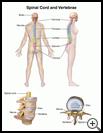
Lumbar Puncture
________________________________________________________________________
KEY POINTS
- A lumbar puncture uses a needle put into the lower part of your child’s back to get a sample of spinal fluid from the area around the spine. It is also used to inject medicine or contrast dye into the area.
- A lumbar puncture can be used to check for infections or problems that affect your child’s brain and spinal cord, or it may be used to give anesthesia to numb the lower body.
- Ask your provider how long it will take to recover and how to take care of your child at home.
- Make sure you know what symptoms or problems you should watch for and what to do if your child has them.
________________________________________________________________________
What is a lumbar puncture?
A lumbar puncture is a procedure used to get a sample of spinal fluid from the area around the spine. It is also used to inject medicine or contrast dye into the area. The term lumbar refers to the lower part of the back, between the tailbone and the ribs. A needle is put into the lower back between the bones of the spine to get the fluid sample or put in medicine or contrast dye. This test is also called an LP or a spinal tap.
Spinal taps are safe. Most babies and young children do not like medical tests or needles and will cry during the test, but a spinal tap is no more painful than drawing blood.
When is it used?
This procedure is used to:
- Check for infections, diseases, or other problems that may affect your child’s brain and spinal cord
- Inject an anesthetic to numb your child’s lower body. This may be done so that your child will not feel any pain during surgery or other procedures. This is known as spinal anesthesia, or “a spinal.”
- Inject drugs to treat cancer or diseases of the nervous system
- Inject contrast dye for X-rays or a CT scan of the spine
How do I prepare my child for a lumbar puncture?
Often no preparation is needed unless your healthcare provider gives you special instructions.
- Your child may or may not need to take regular medicines the day of the procedure. Some medicines or products may increase your child’s risk of side effects. Tell your provider about all medicines and supplements your child takes. Ask your provider if your child needs to avoid taking any medicine or supplements before the procedure.
- Tell your provider if your child has any food, medicine, or other allergies such as latex.
- Follow any other instructions your healthcare provider gives you.
- Ask any questions you have before the procedure. You should understand what your child’s provider is going to do. You have the right to make decisions about your child’s healthcare and to give permission for any tests or procedures.
What happens during the procedure?
A lumber puncture may be done in a clinic, surgery center, or hospital. It usually takes about 30 to 45 minutes.
Before the procedure your child may be given medicine to help relax, but your child will usually be awake during the procedure. Then your child will be given a local anesthetic with a small needle to numb the area. Sometimes, a numbing cream may also be used on the skin.
Older children may sit on the exam table and lean their head and shoulders forward onto a table or pillow. Babies and younger children will lie on one side with their knees bent and pulled up, with their chin touching their chest. Because your child must lie or sit still, someone may need to hold your child during the procedure. These positions allows the bones in your child's spine to spread far enough apart for the healthcare provider to insert a needle into the area where a sample of spinal fluid can be removed or medicine or contrast dye can be injected.
What happens after the procedure?
Your child may need to lie flat for an hour or so after the test. If your child was given medicine to help relax, your child will be watched carefully until fully awake and alert. This may take up to a couple hours.
If your child was given contrast dye, drinking a lot of liquids after the procedure helps the body get rid of the contrast dye.
Your child may have a headache after the procedure. Follow your healthcare provider’s instructions for things you can do to try to prevent or relieve a headache.
Ask your provider:
- How and when you will get your child’s test results
- How to take care of your child at home
- If there are activities your child should avoid and when your child can return to normal activities
- What symptoms or problems you should watch for and what to do if your child has them
Make sure you know when your child should come back for a checkup. Keep all appointments for provider visits or tests.
What are the risks of this procedure?
Every procedure or treatment has risks. Some possible risks of this procedure include:
- Your child may have problems with anesthesia.
- Your child may have headaches if fluid leaks from the needle insertion site.
- Your child may have an infection or bleeding.
- Other parts of your child’s body may be injured during the procedure.
Ask your healthcare provider how the risks apply to your child. Be sure to discuss any other questions or concerns that you may have.
Last modified: 2022-01-03
Last reviewed: 2018-11-28

